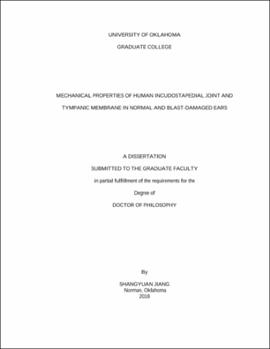| dc.contributor.advisor | Gan, Rong | |
| dc.contributor.author | Jiang, Shangyuan | |
| dc.date.accessioned | 2018-05-11T19:43:15Z | |
| dc.date.available | 2018-05-11T19:43:15Z | |
| dc.date.issued | 2018-05-11 | |
| dc.identifier.uri | https://hdl.handle.net/11244/299908 | |
| dc.description.abstract | The human ear consists of outer ear, middle ear and inner ear. The mechanical properties of the incudostapedial joint (ISJ) and tympanic membrane (TM) are critical to the sound transmission function of the ear because the transformation of the acoustic pressure to the mechanical vibration relies on the TM while the vibration of the ossicles transmits through ISJ into the cochlea. However, the dynamic properties of ISJ have not been reported in previous studies. Moreover, injuries in the TM and ISJ have been observed in ears exposed to blast overpressure. The structural and functional changes in the ISJ and TM during and after blast exposure were not investigated. In addition, the sound transfer function of the middle ear has not been characterized under blast overpressure. The absence of these mechanical properties and data obtained from function tests of the human ear impedes the improvement of the accuracy of the finite element (FE) model of the human ear which was designed to simulate the response of the ear to the blast overpressure.
In this study, biomechanical measurements were conducted on TM and ISJ specimens harvested from human cadaveric temporal bones (TB). The dynamic properties of the ISJ were measured using dynamic mechanical analyzer (DMA) at frequencies from 1 to 80 Hz at three temperatures of 5, 25 and 37 °C. The frequency-temperature superposition (FTS) principle was used to extrapolate the complex moduli of the ISJ specimens to 8 kHz. Then, the mechanical properties of ISJ under high-strain-rate deformation were measured by split Hopkinson tension bar. FE simulations on ISJ demonstrated that the behavior of the joint under harmonic and impulse loads was closely related to the structure and the mechanical properties of the joint components.
For biomechanical measurement of the TM, the full-field surface motion of human TMs was measured by scanning laser Doppler vibrometry (SLDV) over a frequency range from 1 to 8 kHz under normal and post-blast conditions. An FE model of the human TM with multilayer microstructure and orthogonal fiber network was built and successfully characterized the features of the surface motion measured from the normal and damaged ears. The consistency between the experimental data and model simulation suggested that the blast-induced damage to the collagen fibers in the TM.
To investigate the mechanism of the induction of the damage, a dual laser setup was established to capture the real-time motion of the TM in the period of time during which the blast waves were propagating through the ear. The motion of the TM umbo within 5 ms after the blast exposure arrived was measured and normalized by the blast pressure levels. The response of the ear was simulated by an FE model of human ear by applying the same input pressure at the entrance of the ear canal. The TM movement and pressure showed good consistency between the results the FE model prediction and the experimental data. The nonlinear behavior of the human middle ear under blast overpressure was observed.
In this dissertation, the behavior of the human ISJ and TM in the normal and blast-damaged was characterized through a series of biomechanical measurements. The quantitative data can be used as input for FE models of the human ear to improve their accuracy on predicting the behavior of the ear under both normal and blast conditions. The methods used in this series of studies provide novel approaches for micron-level biomechanical measurement under dynamic or impulse loads. | en_US |
| dc.language | en_US | en_US |
| dc.subject | Ear | en_US |
| dc.subject | Human temporal bone | en_US |
| dc.subject | Biomechanics | en_US |
| dc.subject | Blast | en_US |
| dc.subject | Tympanic membrane | en_US |
| dc.subject | Incudostapedial joint | en_US |
| dc.subject | Mechanical properties | en_US |
| dc.title | MECHANICAL PROPERTIES OF HUMAN INCUDOSTAPEDIAL JOINT AND TYMPANIC MEMBRANE IN NORMAL AND BLAST-DAMAGED EARS | en_US |
| dc.contributor.committeeMember | Sikavitsas, Vassilios | |
| dc.contributor.committeeMember | Matthias, Nollert | |
| dc.contributor.committeeMember | Edgar, O'Rear | |
| dc.contributor.committeeMember | Harold, Stalford | |
| dc.date.manuscript | 2018-05-11 | |
| dc.thesis.degree | Ph.D. | en_US |
| ou.group | College of Engineering::Department of Bioengineering | en_US |
| shareok.nativefileaccess | restricted | en_US |
